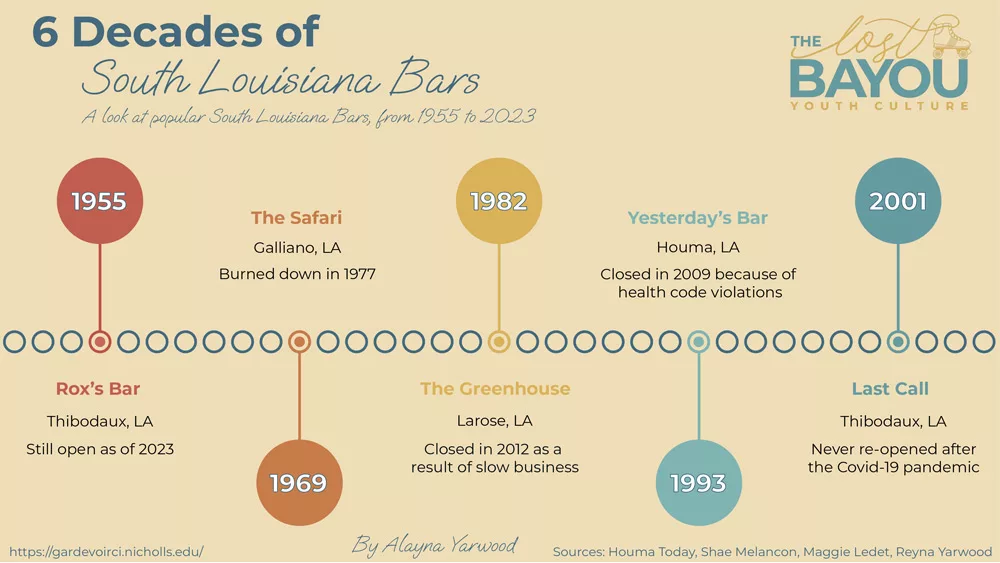Dominic Lasseigne Staff
The bar scene was a centerpiece in the lives of Southeast Louisiana’s youth during the end of the 20th century. Every weekend, the young adults of Lafourche, Terrebonne and Assumption Parish would show up to their favorite bars and clubs for long nights of music, dancing, and drinking.
The South Lafourche region hosted a thriving nightlife. The Safari, a club in Cut Off, was decorated with palm branches and bamboo. According to Matt Dufrene, a longtime Galliano resident, The Safari was the most ambitious club down the bayou.
“The decorations weren’t really like anything we had seen before at that time,” Dufrene says. “It’s a lot like the bars and clubs you see in big cities today. They had a theme and they stuck to it.”
"It's a lot like the bars and clubs you see in big cities today. They had a theme and stuck to it."
Matt Dufrene
Locals recall streakers running through the building one Saturday night, to the dismay of some of the older bar-goers.
The Big Apple, a disco club that set itself apart with its very large size, grew popular after The Safari burnt down in 1977. It featured a light-up dance floor, a disco ball, and a large U-shaped bar. It later became The Little Apple in 1984 when the main club closed down, leaving just the bar.
Not only did the setup and theme of bars draw in crowds, but so did the live music.
Toby Melancon, the owner of The Greenhouse, a bar in Cut Off, says he was able to pull bands from all over the United States; and sometimes out of the country. Dream Junkies, DNA, Crush, Enter the Machine, The Stranger, and Uncrowned all performed on The Greenhouse Stage.
In Assumption Parish, The Rainbow Inn was home to many swamp pop musicians, a South Louisiana genre of music combining country with cajun and creole traditional tunes. People would tune in to see artists like The Richard Brothers and Don Rich.
The Southeastern Louisiana region was booming with many great bars.
Thibodaux youth enjoyed the trifecta of Iron Horse, The Foundry, and Colonel’s Retreat. Other popular bars and clubs were also visited frequently such as Lee Brothers’ Dance Hall and The Shady Pecan.
“It’s a lot like it was back in the ’80s these days,” says Julie Chouest, a native of Cut Off. “The kids will drive an hour or however long to Houma and Thibodaux to go drink. We did the same, but there was a lot more stuff to do here down the bayou then too.”
WHAT CHANGED?
Louisiana changed its legal drinking age from 18 to 21 on September 1, 1986. The change was a result of the National Minimum Drinking Age Act, which was passed by the United States Congress. Before the change, individuals 18 years or older could buy and drink alcohol.
Nicole Boudreaux, assistant professor of Mass Communication at Nicholls State University, recalls the change in policy
“I was almost 20 — so close,” Boudreaux says. “It was the weirdest thing. One day you had the right to drink legally, and the next day they were putting a big ‘X’ on your hand with a sharpie to indicate that you weren’t 21.”
According to Boudreaux, the beginning was the most strict. If you were underage and caught with a drink, most bars would kick you out. She says that people were creative with erasing the ‘X’ mark, however.
Many of these bars and clubs have since closed down: The Safari burnt down; The Big Apple exists but only as the Red Apple Inn; and the shopping center that The Greenhouse was located in wasn’t maintained after hurricanes, leading to its closure in 2012.
The closures of these once popular bars and clubs have contributed to the decrease of activities for Southeast Louisiana’ youth to participate in and, consequently, a lost youth culture.

